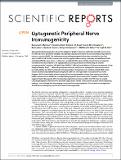Optogenetic Peripheral Nerve Immunogenicity
Author(s)
Revol, Emilie C. M.; Maimon, Benjamin E.; Diaz, Maurizio A.; Schneider, Alexis M.; Leaker, Benjamin David; Varela, Claudia Elena; Srinivasan, Shriya Sruthi; Weber, Matt; Herr, Hugh M; ... Show more Show less
Downloads41598-018-32075-0.pdf (1.836Mb)
PUBLISHER_CC
Publisher with Creative Commons License
Creative Commons Attribution
Terms of use
Metadata
Show full item recordAbstract
Optogenetic technologies have been the subject of great excitement within the scientific community for their ability to demystify complex neurophysiological pathways in the central (CNS) and peripheral nervous systems (PNS). The excitement surrounding optogenetics has also extended to the clinic with a trial for ChR2 in the treatment of retinitis pigmentosa currently underway and additional trials anticipated for the near future. In this work, we identify the cause of loss-of-expression in response to transdermal illumination of an optogenetically active peroneal nerve following an anterior compartment (AC) injection of AAV6-hSyn-ChR2(H134R) with and without a fluorescent reporter. Using Sprague Dawley Rag2−/− rats and appropriate controls, we discover optogenetic loss-of-expression is chiefly elicited by ChR2-mediated immunogenicity in the spinal cord, resulting in both CNS motor neuron death and ipsilateral muscle atrophy in both low and high Adeno-Associated Virus (AAV) dosages. We further employ pharmacological immunosuppression using a slow-release tacrolimus pellet to demonstrate sustained transdermal optogenetic expression up to 12 weeks. These results suggest that all dosages of AAV-mediated optogenetic expression within the PNS may be unsafe. Clinical optogenetics for both PNS and CNS applications should take extreme caution when employing opsins to treat disease and may require concurrent immunosuppression. Future work in optogenetics should focus on designing opsins with lesser immunogenicity.
Date issued
2018-09Department
Massachusetts Institute of Technology. Institute for Medical Engineering & Science; Massachusetts Institute of Technology. Department of Biological Engineering; Massachusetts Institute of Technology. Department of Electrical Engineering and Computer Science; Massachusetts Institute of Technology. Media Laboratory; MIT-Harvard Center for Ultracold AtomsJournal
Scientific Reports
Publisher
Nature Publishing Group
Citation
Maimon, Benjamin E., Maurizio Diaz, Emilie C. M. Revol, Alexis M. Schneider, Ben Leaker, Claudia E. Varela, Shriya Srinivasan, Matthew B. Weber, and Hugh M. Herr. “Optogenetic Peripheral Nerve Immunogenicity.” Scientific Reports 8, no. 1 (September 19, 2018). © 2018 The Authors
Version: Final published version
ISSN
2045-2322